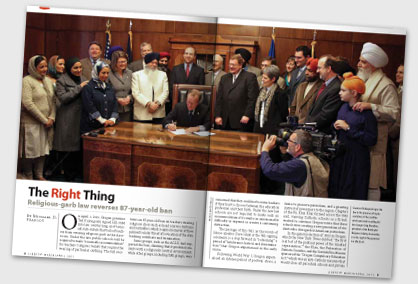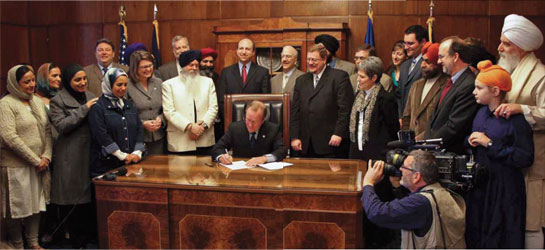The Right Thing
Michael D. Peabody March/April 2011
On April 1, 2010, Oregon governor Ted Kulongoski signed HB 3686 into law, overturning an 87-year-old state statute that barred teachers from wearing religious garb in the classroom. Under the law, public schools will be required to make "reasonable accommodation" for teachers' religious beliefs that require the wearing of particular clothing. The bill overturns an 87-year-old ban on teachers wearing religious dress such as head scarves, turbans, and yarmulkes, which required removal of these garments under threat of revocation of the state teaching certificate and termination.
Some groups, such as the ACLU, had supported the ban, claiming that it provided students with a religiously neutral environment, while other groups, including Sikh groups, were concerned that they could not become teachers if they had to choose between the education profession and their faith. Under the new law schools are not required to make such an accommodation if it results in unreasonable difficulty or expense or creates a continuing distraction.
The passage of this bill, in the words of House speaker Dave Hunt at the bill-signing ceremony, is a step forward in "redeeming" a period of "intolerance, hatred, and discrimination" that Oregon experienced in the early 1920s.
Following World War I, Oregon experienced an intense period of postwar stress, a desire to preserve patriotism, and a gnawing distrust of newcomers to the region. Chapters of the Ku Klux Klan formed across the state and, viewing Catholic schools as a threat, worked to convince Oregon voters that these schools were creating a new generation of students who disregarded American patriotism.
In the general election of 1922 in Oregon, which the New York Times dubbed "the first real test of the political power of the 'masked organization,'" the Klan, the Federation of Patriotic Societies, and the Scottish Rite Masons sponsored the "Oregon Compulsory Education Act," which was an anti-Catholic measure that would close all parochial schools and private military academies and would require all children between the ages of 8 and 16 to attend public schools. Parents who did not comply or who sent their children to private or parochial schools would be fined or imprisoned.1
Backers of the measure advertised the measure under the slogan of "One Flag, One School, One Language."2
Promoters unleashed their rhetoric with little regard for Oregon parents. "Now is the time to pass this measure, insuring that in Oregon all of our children will be educated to a common patriotism, common ideals, and a unified allegiance to our institutions. . . . We must now halt those coming to our country from forming groups, establishing schools, and thereby bringing up their children in an environment often antagonistic to the principles of our government. . . . Mix these with prejudices in the public school melting pot for a few years while their minds are plastic and finally bring out the finished product—a true American."3
Despite the fact that Catholics, Seventh-day Adventists, Episcopalians, Presbyterians, and Lutherans rallied against the new law, which by that point was attracting national attention, Oregon voters approved the measure by a majority of 13,000.
Despite its passage by a raw majority, the constitutionality of the bill was successfully challenged. In 1924 the Supreme Court of Oregon declared the measure unconstitutional, and in 1925 the U.S. Supreme Court agreed in a unanimous 9-0 decision.4
While the Supreme Court recognized that certain rights should not be subjected to a majority vote, a bit of the legacy of intolerance remained in place until April 1, 2010. In 1923 Kaspar K. Kubli, the speaker of the Oregon House of Representatives, who was said to possess "winning initials," successfully promoted anti-immigrant law. Included were laws that banned Japanese immigrants from owning property and required immigrant business owners to display signs indicating their national origin. Although these were subsequently eliminated or overturned, one part remained. Mr. Kubli had championed a statute that prohibited teachers from wearing religious garb in the classrooms. The statute was designed to keep prior Catholic schoolteachers, including priests and nuns, from teaching in public schools. The mandatory penalty for violation was revocation of the state teaching certificate.
Although the Oregon law was initially passed to keep Catholic clergy from having an undue influence on public schools, the rationale for the law became one of protecting public school students from undue influence by teachers of any background who wore religious garb. Oregon courts performed a balancing act between protecting students from undue religious influence, implicating the establishment clause, and the rights of teachers to practice their beliefs that required wearing particular religious garb.
Oregon was one of only three states to have prohibitions on teachers' dress, the others being Nebraska and Pennsylvania.
The blanket prohibition on teachers wearing religious dress made it nearly impossible for teachers to be employed if their religion required wearing particular religious garb.
In 1983 the Eugene School District, relying on the 1923 law, revoked a Sikh convert's teaching certificate and then fired her because of her lack of certification because she wore a turban and white clothing as part of her religious dress. Janet Cooper, who had taken the name Karta Kaur Khalsa, agreed with the district that the public school classroom was not the proper place to proselytize but held that her rights had been restricted.
Khalsa took the school district to court, and the Oregon Court of Appeals ruled that the mandatory revocation of her teaching certificate was unconstitutionally harsh. However, the Oregon Supreme Court disagreed. In the opinion Justice Hans Linde wrote that the law would not be violated if the teacher occasionally wore religious apparel when going to a ceremony, but "only wearing religious dress as a regular or frequently repeated practice while teaching is grounds for disqualification."
In 1986 The Oregon Supreme Court did note that the law "might indeed" infringe on the First Amendment right of teachers' free exercise of religion, but ruled that this was outweighed by the public schools' need to avoid the appearance of endorsement of specific religions.
The U.S. Supreme Court by a vote of 6-3 declined to hear the case. In 1991, a Muslim teacher in Pennsylvania lost a similar case when she wanted the right to wear a head scarf in the classroom. The Oregon prohibition attracted attention in 2009 when the Oregon Legislature passed the Oregon Workplace Religious Freedom Act (WRFA), which increased protection for religious employees who observed holy days or wore religious garb but specifically excluded teachers from the garb provision. Although WRFA backers wanted to include teachers in the 2009 bill, the American Civil Liberties Union among other groups had requested the exclusion on the grounds that teachers should not wield undue religious influence in the classroom. Under pressure from Sikh rights groups as well as other civil rights groups, the U.S. Justice Department was beginning to signal that it would investigate whether the Oregon ban violated Title VII of the federal civil rights law since it had been unevenly applied. For instance, Christian teachers could wear crosses as jewelry, but Muslim scarves and Sikh turbans were banned.
The Oregon prohibition attracted attention in 2009 when the Oregon Legislature passed the Oregon Workplace Religious Freedom Act (WRFA), which increased protection for religious employees who observed holy days or wore religious garb but specifically excluded teachers from the garb provision. Although WRFA backers wanted to include teachers in the 2009 bill, the American Civil Liberties Union among other groups had requested the exclusion on the grounds that teachers should not wield undue religious influence in the classroom. Under pressure from Sikh rights groups as well as other civil rights groups, the U.S. Justice Department was beginning to signal that it would investigate whether the Oregon ban violated Title VII of the federal civil rights law since it had been unevenly applied. For instance, Christian teachers could wear crosses as jewelry, but Muslim scarves and Sikh turbans were banned.
In 2010 the Sikh American Legal Defense and Education Fund (SALDEF), the American Jewish Congress, the Northwest Religious Liberty Association, and the Council on American-Islamic Relations, as well as other groups, pushed for legislation overturning the ban. The Sikh Coalition alone sent almost 10,000 messages to legislators urging them to end the ban.
On April 1, 2010, 87 years after the original law was passed, Governor Ted Kulongoski signed HB 3686 into law, overturning the ban. The new law will go into effect after the 2010-11 school year. In a signing statement, Kulongoski recognized the need to balance both religion clauses of the First Amendment. He wrote that in order to address issues that arise "at the intersection of the teacher's right to practice his or her religion and the students' right to be taught in a religiously neutral environment," that the Oregon Bureau of Labor and Industries create guidelines to encourage "clarity and predictability" in how the law will be implemented.
At the signing ceremony Greg Hamilton, president of the Northwest Religious Liberty Association, affirmed that "all people of faith can be blessed by this, a constitutional balancing standard between the free exercise clause and the separation of church and state. It's a very reasonable bill. The oppression has finally been lifted." As Governor Kulongoski wrote, ending the ban was "the right thing to do."
A video of the April 1, 2010, bill-signing ceremony and more information about HB 3686 is available online at the Northwest Religious Liberty Association Web-site at www.nrla.com/article.php?id=86.
1 "An Oregon Venture," New York Times, Nov. 12, 1922, Sunday section, editorial, p. 38.
2 Bend Bulletin, Oct. 31, 1922. Advertisement.
3 Ernest Harvier, "What the Klan Did in Oregon Elections," by New York Times. Dec. 3, 1922, Sunday section, editorial, p. 40.
4 Pierce v. Society of Sisters of the Holy Names of Jesus and Mary, 268 U.S. 510 (1925).
Article Author: Michael D. Peabody
Michael D. Peabody is an attorney in Los Angeles, California. He has practiced in the fields of workers compensation and employment law, including workplace discrimination and wrongful termination. He is a frequent contributor to Liberty magazine and editsReligiousLiberty.TV, an independent website dedicated to celebrating liberty of conscience. Mr. Peabody is a favorite guest on Liberty’s weekly radio show, “Lifequest Liberty.”